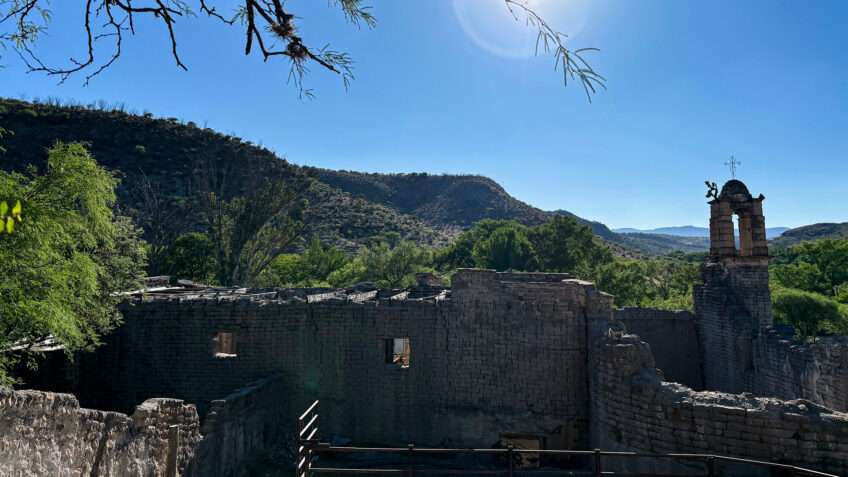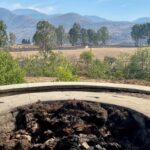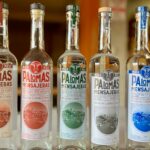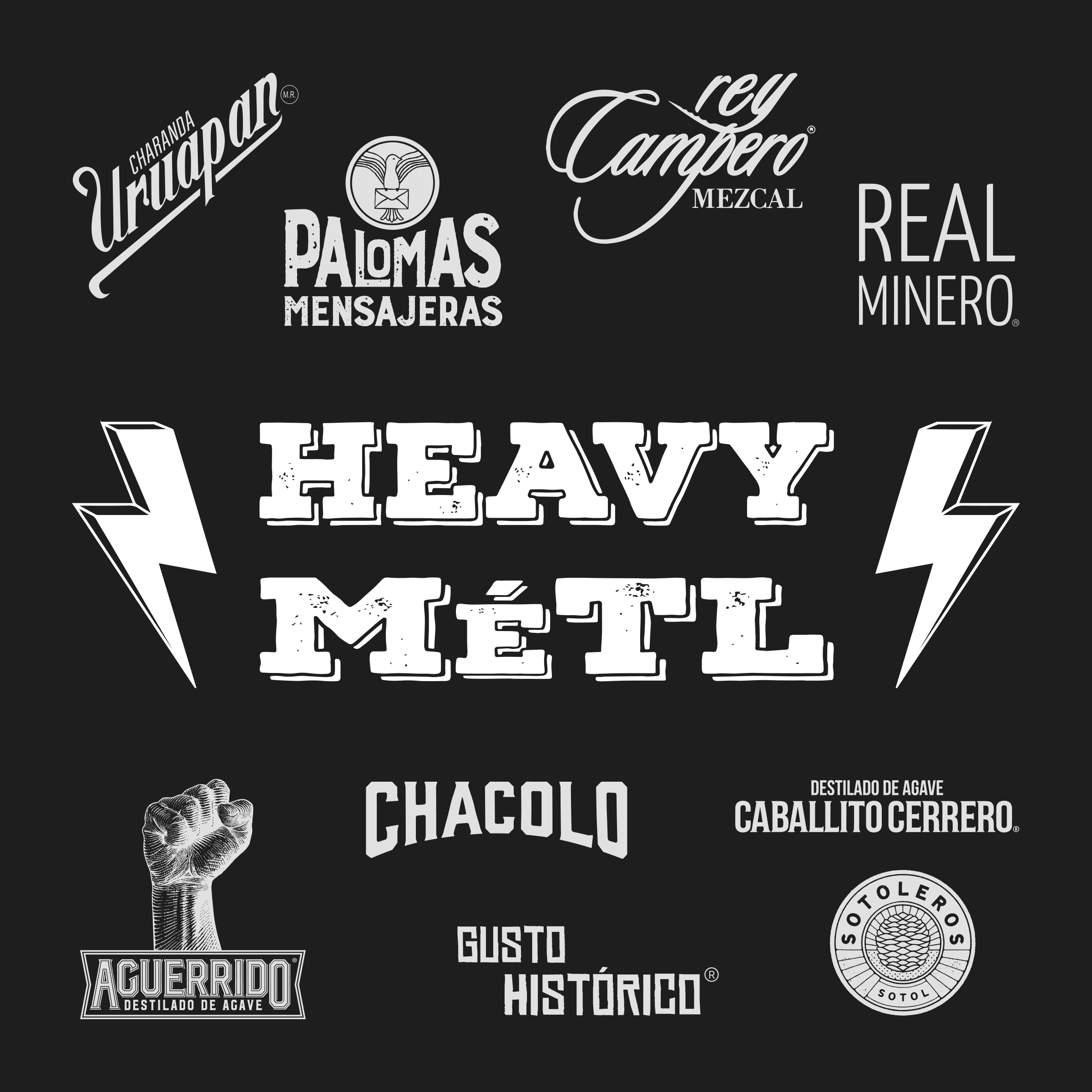Nowadays, a wide variety of maguey spirits are distilled in the Hacienda de San Jose Acevedo, but it wasn’t always that way. The property is an oasis of floral life, with giant cypress trees lining the banks of the Rio Mezquital. The river slowly meanders alongside the remote cluster of old Spanish buildings, high in the hills of the Sierra Madre mountains, about an hour outside of Nombre de Dios, Durango. The property is a reminder of what was, a piece of history that was almost lost to time, and almost entirely reclaimed by the plants, animals, and rough countryside that surrounds it. Even now, the property remains hidden. Without the proper guide, you’d never know it was there. And without the proper stewards, it would be nothing more than a memory in the minds of the few remaining elders who lived there ages ago.
Haciendas in Mexico
Haciendas like this were built all over Mexico, starting in the early 1500s as the Spanish crown issued land grants to promote economic growth and development in the Spaniard’s newly conquered rural lands. The term hacienda was used somewhat loosely, but it typically referred to estates of significant size. Smaller properties were typically called estancias or ranchos. All colonial haciendas were owned almost exclusively by Spaniards and criollos, which was the term for people of Spanish decent who were born in Mexico during that time. These haciendas could be plantations (for animals or farming), mines, or factories. Many haciendas combined a mix of these activities.
Most of the people who worked at these haciendas were recruited from the existing nearby communities. Depending on the location, some of them could commute to work at the hacienda by foot or by horse each day. In other more remote scenarios, the workers lived at the hacienda at which they worked. In instances where the workers lived at the hacienda, small town-like establishments were constructed within the hacienda to support the complex needs of daily life. This included building houses, churches, and infrastructure for clean drinking water and food. While the hacienda system provided some economic opportunities to rural communities, it also perpetuated a rigid class system that was tough to break.
Hacienda de San Jose Acevedo
The Hacienda de San Jose Acevedo, or San Nicolas as Google Maps calls it, was never officially registered with the Spanish government. It’s for this reason that the full history of the hacienda remains somewhat unclear. What is known has been passed down through the generations of people living in the rural, ejido-filled hills south of Nombre de Dios. The exact year of it’s construction is not known, but local oral history says that the hacienda was constructed 15 years after Nombre de Dios was founded. That means the hacienda was constructed sometime around the year 1577.

The yellow star at the bottom of the image shows the Hacienda de San Jose Acevedo, or San Nicolas as Google calls it, far into the Sierra Madre mountains that surround the town of Nombre de Dios, Durango.
Nombre de Dios is the “big town” in this region. It currently has a population of about 5,300 people. The hacienda is about an hour from this town, through a series of ejidos that cover the dry, mountainous terrain. There are a few twisting rivers that cut through the mountains, and the Hacienda de San Jose Acevedo is located on one of these rivers. Due to the remote location of the hacienda the people who worked there also lived onsite. There were several living quarters, a church, and aqueducts constructed to provide fresh drinking water.
The hacienda system was abolished in Mexico in 1767, but local histories say that Hacienda de San Jose Acevedo remained continuously occupied through at least the 1950s. The hierarchal system of Spanish command would have left long before that, so it is most likely that the hacienda was occupied by people who chose to live there and use the land for their own purposes, like for growing crops and raising cattle. There are also local legends that there is gold hidden somewhere on the property, adding to the murky mystique of the property’s unclear history.

A recent photo of the entrance to the Hacienda de San Jose Acevedo, now the home of Maguey Spirits: Burrito Fiestero, Señor Sotol, and MG Mezcal.
About 70 years ago, the hacienda was abandoned. The property slowly devolved into ruins over that time. The roofing of the buildings collapsed, the brick walls began to crumble once exposed to the weather and rain. Plants climbed into the homes and took root as the surrounding hillside slid over the empty township like a warm, thick blanket on a cold winter night. The earth takes back the land quickly, and the old hacienda was an archaeological ruin before long.
New Stewards of the Land
Alejandro and Christian Rossbach were raised in Cancún, Quintana Roo, Mexico. They left home in their early teens to work for their uncle in Oaxaca. The uncle owned and operated the IBA Mezcal brand in San Pablo Huixtepec, Oaxaca. This was their first experience with mezcal and the spirits industry and they worked for their uncle for about 3 years in Oaxaca. After this time, a new idea began to grow. They were perplexed why so much of the mezcal on the international market came from Oaxaca. Why is so much of it Espadin? Why is so much of it from Oaxaca? There are so many diverse flavors in mezcal, why not introduce those nuances to the world? They began exploring the idea of opening people’s eyes (and palates) to something from somewhere outside of Oaxaca. They knew that regions like Guerrero, Michoacán, and Durango were all making great spirits, but were largely unknown in the international spirits market.
These two brothers are true entrepreneurs. When Alejandro was 20 years old, and Christian just 17, they decided to venture out on their own and create their own mezcal project. They started by visiting as many mezcal-producing regions as they could, searching for a place that had a distinct mezcal, plenty of agave, and local communities that would want to engage. After about 2 years of research and travel, including a short stop in Guerrero, they landed in Durango. They decided to call the new project Maguey Spirits to allow them flexibility with the projects they wants to create. Under the Maguey Spirits company, they eventually launched MG Mezcal, Burrito Fiestero, and Señor Sotol.
When they first launched the new project in Durango, they began working with maestro mezcalero Arturo Conde in the community of Pino Suárez, Durango. While bottling and selling Arturo’s mezcal, they met his uncle, Juan Manuel Conde. Juan had just returned from working in a tobacco processing facility in the US. He’d been working in the US for 15 years, doing hard labor for long hours, and he was tired of that lifestyle. He was looking to permanently return to Mexico to be with his family. Juan began working part-time at the vinata in Pino Suárez. He was reliable and driven, eager for an opportunity to run his own vinata and continue the traditions of these rural communities.

Christian and Alejandro Rossbach holding bottles of Burrito Fiestero and Señor Sotol on the land, high above the hacienda. These are the hills that produce the agave and sotol used in their spirits. Some of this land behind them belongs to ejidos, who they work with on agave reforestation projects.

Mezcalero Juan Manuel Conde pouring high ABV puntas into a cow horn.
There was a natural connection between Juan, Alejandro, and Christian. The group set out looking for a ranch on which to sustainably grow their agave and produce their spirits. They needed a lot of land, and they needed a reliable water supply, but they also wanted somewhere that felt right. Not just any land would do. They visited properties all over the state of Durango. After dozens upon dozens of failed visits, they got word of an abandoned hacienda, way up in the hills outside of Nombre de Dios.
They arrived at the Hacienda de San Jose Acevedo to find it in ruins. The buildings had collapsed. Trees and plants covered everything, and there were snakes from the nearby river that inhabited the entire property. It was a mess, yet there was something about it that drew them in. The old church bell-tower still stood tall over the ruins. The Spanish aqueducts still directed the natural spring water throughout the property, and there was tons of mountainside land, with much of it already home to thousands of wild maguey. Once they tasted the water from the spring, they knew that this was it.
A Chance Meeting in Austin, TX
We’d been fans of the Burrito Fiestero mezcal ever since we first tasted it. There was something different about it, something uniquely Duranguenses in the flavor and profile that we hadn’t tasted before. The brand had been listed on our website for a couple of years. Tyler and I both had Burrito Fiestero bottles in our private collections, and we’d exchanged a few emails with Alejandro and Christian, but we’d never met them. Then, on a random day at The Austin Shaker, I met Alejandro in person for the first time. He was doing a tasting of the new Burrito Fiestero Castilla release. This was one of their select, rare agave, ancestral releases. The agaves were hand-mashed with axes, fermented in underground, wood-lined pits, and distilled in stills that use clay pots on the bottom chamber, with the upper chamber made of the traditional wood (viejo montera). It’s an incredibly impressive spirit and was different from anything I’d ever tasted. At the end of the tasting, Alejandro invited us see the production in Durango.
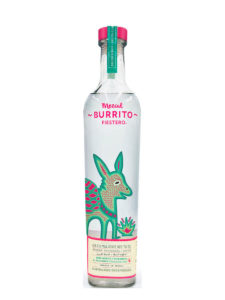
Burrito Fiestero Cenizo artesenal
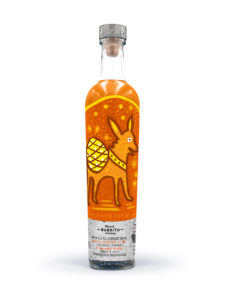
Burrito Fiestero Castilla ancestral
Hauling 1.6 Tons of Lamparillo
Two years later, we found ourselves in Durango. We’d coordinated a visit to Ultramundo mezcal in La Zona del Silencio as our first stop. After spending a few days in the northern desert with Sergio, who runs the brand, we headed 5 hours south with 1.6 tons of maguey Lamparillo in tow. The Lamparillo had been harvested on Sergio’s 25,000 acre ranch as part of a collaboration batch between Ultramundo, Burrito Fiestero, and Mezcal Reviews. We’ll post more about that later.
Finding the hacienda turned out to be more difficult than we’d expected. We were hauling the 1.6 tons of agave up a steep mountain slope when Sergio’s truck began to overheat. He stopped the truck halfway up the hill. There was no cell phone service, but he was certain we’d taken a wrong turn somewhere. We all climbed out, opened some beers, nipped at some Ultramundo Lamparillo puntas, and climbed further up the hill by foot to see if we could find cell service. After awhile, Sergio’s phone picked up service and he called Alejandro.
Indeed we’d taken a wrong turn in one of the ejidos and ended up on the wrong side of the river, a few miles from the hacienda. We climbed back into the truck and slowly started backing down the steep canyon with the trailer full of agave behind us, using it’s weight to drag us down toward the river several hundred feet below. Sergio tried to keep his foot on the brake and the trailer straight in line with the truck, but the 1.6 tons of agave pulled us wherever gravity defined. Sergio would turn the wheel completely to the left or right, yet the truck would continue to slide straight backwards on the loose rocks and dirt. With no turnouts on the rural dirt road, we had no choice but to succumb to a controlled slide backwards toward the river far below.
As we drew closer to the river, the road beneath us began to slowly flatten out. Sergio found a place to turnaround and we forded the river with the agave in tow, climbing back up the other side of the canyon with great difficulty due to the steep slope and heavy load. We continued down the dirt road from which we’d taken leaving Nombre de Dios. About 20 minutes back toward Nombre de Dios, we were greeted by Alejandro and Christian in an ATV. After a quick greeting, we followed them back to the hacienda.
An Old Horno
The version of the Hacienda de San Jose Acevedo that we saw was far from ruin. In fact, it had been largely reconstructed and converted into a mezcal vinata over the past 3 years. There were still some buildings that clearly needed additional work, but they were no longer covered with plants and snakes. The old church bell tower stood tall over the ancient hacienda in the evening sun as we arrived. The lush, green surroundings were an abrupt change from the dry mountainside where we’d been stuck hauling agave an hour earlier. Tall cypress trees lined the river on which the entire hacienda was built, providing shade and shelter from the hot sun.

The cypress-lined Río Mezquital that runs alongside the hacienda.
We greeted mezcalero Juan Manuel Conde briefly. Alejandro and Christian were eager to show us around the hacienda. We started at a small horno that they explained they use for their ancestral mezcal production only. It has a capacity of a little over 3 tons, which is very small, especially in comparison to the other hornos we saw throughout Durango.
“We found this on the property,” Alejandro explained about the oven. “We actually didn’t know this was here when we decided to use this property for our vinata. We didn’t know it, but they used to produce agave spirits here. We aren’t the first.” Based on oral histories in the region, which they learned later, they estimate that this small horno is about 100 years old.

The ancient mezcal horno that they found on the property after beginning to clear the plants that had taken over this area.
Given the size of the hacienda, the brothers were able to use the space to create several different vinatas in one. Each area of the hacienda is dedicated to the production of a different type of spirit, and they keep them all separate. There is an area for their ancestral mezcal production, an area for their artesenal mezcal production, an area for their “pechuga” production (which they market as MG Mezcal), and an area for their sotol production (Señor Sotol). Each area has it’s own equipment for milling, fermentation, and distillation. None of the equipment is used to produce multiple spirits. The ferment from their sotol, for example, won’t impact the ferment of any of their agave. The production in all of these areas is led by maestro Juan Manuel Conde.
After viewing the old horno, they took us up to see a water collection area on the higher part of the hill that holds the hacienda. This water collection area is continuously filled by the freshwater spring, which is further up the hill. Water is channeled via the Spanish-built aqueducts that still work today. All the water used at the hacienda is this mountain spring water, including all of the water used in the mezcal and sotol production. About 90% of the spring water flows directly into the river, while 10% is diverted via the aqueducts to the hacienda.
Inside the water collection area, they’d put the wooden viejo montera tops to the ancestral stills. This is a common practice in Durango. The producer will put the wooden viejo top of the still in water when it’s not in use so that the wood does not dry up and crack. They also told us that they’d found a 6 meter python in the collection tank one morning. They’d tried to fight it off, but after it bit a few people, they let it slither off toward the nearby river. Thankfully, the python was not around during our visit. We did however see a coral snake about 20 minutes later. It slithered in and out of a hole in a begaso brick built building.

The wooden viejo montera tops of the ancestral stills left in water to preserve the wood.
The Agave Nursery
The majority of the agave in the nursery is grown from seeds that were collected from the property. Typically an agave will spend 3 years in their nursery before being transplanted to the hills that surround the buildings on the hacienda. They plant about 50,000 agaves per year and typically have about a 95% success rate when the agaves are moved to the hills to continue growing in a wild environment. They grow primarily maguey Cenizo, Verde, and Tepemete, and the Cenizo is known for cross-breeding extensively with other agaves across the property. The nursery was an impressive set up. It’s one of the largest agave nurseries we’ve seen in our travels through Mexico.
Juan also keeps potted flowers in the nursery. He explained to us that any plagues or insects will attack the flowers before they attack the agave. The flowers are his canary in the coal mine (an idiom he was not aware of prior to our arrival). If the flowers grow sick, he has time to remediate the issue before it impacts the agave.

The agave nursery used to cultivate maguey Cenizo, Verde, and Tepemete.

Agave growing very close together from seeds. These will eventually be transplanted into individual containers, and then into the hills surrounding the hacienda.
Artesenal Mezcal Production
The area dedicated to their artesenal mezcal production is built almost entirely of bagaso bricks. Bagaso is the word used for the spent agave fibers after they are removed from the still, and it can be formed into bricks for construction purposes. Most of the reconstruction work the team has done on the abandoned buildings of the hacienda has been using these same bagaso bricks. In this way, the mezcal they produce is helping to rebuild a piece of history on this land. This area of artesenal production is intentionally built much larger than it needs to be right now. They built it larger to anticipate the future growth of the Burrito Fiestero brand.

The Burrito Fiestero artesenal mezcal production area. This area was intentionally built to support capacity several times the current demand. This way, when demand increase, they can simply add more necessary equipment and don’t need to expand the existing building further.
For their artesenal production, they have three large hornos. The largest holds 30 tons of agave. The agave in this area is milled via a mechanical shredder. After milling, the shredded agave is laid to rest on the floor for one day. It’s then fermented in 600 liter free-standing, wooden fermentation tanks using spring water and naturally occurring open-air yeasts. To kickstart the fermentation, Juan will heat some water in one of the stills. He adds the hot water to the milled agave when he puts the agave into the fermentation tanks. Fermentation here usually only takes 2-3 days, which is significantly faster than regions like Oaxaca, where it can take upwards of a week for agave to ferment.

Two of the larger ovens used to cook agaves for artesenal mezcal production. Notice all of the industrial wood scraps that are used for heating the stills and the ovens.

Maguey Cenizo fermenting for artesenal mezcal production. For the artesenal production, the team ferments in free-standing wooden tanks, similar to what you’d see in Oaxaca. There are different fermentation methods used for their sotol, ancestral mezcal, and mezcal “gin.”
Once fermented, the agave is distilled in 1,000 liter copper pot stills that were handmade in Michoacán, Mexico. Juan’s blending process is also unique. He will take the first distillation puntas, or agua vino as it’s known in this region, and use that to blend directly with the 2nd distillation. Typically this first distillation puntas is about 40-45% ABV, and he blends that into the second distillation hearts to achieve the flavor that he prefers.

The copper alembic stills used for their artesenal mezcal production only. There are different stills used for their sotol, ancestral mezcal, and mezcal “gin.”
Outside of the artesenal production area, they have an underground bio-digester. This is similar to a septic system. It contains enzymes that are specifically formulated to breakdown the distillation wastewater. This is their way of ensuring that they are not polluting the nearby river with any byproducts that may be harmful to the wildlife in the area. The whole hacienda has been re-built with this type of environmental design. The only electricity available at the hacienda is solar powered, and all of the wood used in mezcal production is byproduct, waste-wood scraps from wood production facilities in Durango. Christian is the chief engineer behind almost all of this impressive design.
Both Alejandro and Christian are vegetarian, so they do not feature any pechugas in their agave lineups. Juan once made a pechuga out of a wild boar that they killed on the property, but that was just a small 20 liter batch using maguey Verde. So when the brothers refer to their pechuga, they’re actually talking about what they market as an agave gin. They make this mezcal gin using maguey Cenizo. Instead of adding a chicken breast to the still, they use a blend of botanicals and herbs that are harvested from the surrounding area. This includes ingredients like ancho chile, hibiscus flower, avocado leaves, and lemongrass. The building dedicated for their pechuga distillation is a very small old barn. This is where they produce their brand, MG Mezcal. The “MG” stands for “Mezcal Gin,” which regulatory bodies wouldn’t allow them to write directly on a bottle. That said, try your favorite gin cocktail with MG Mezcal next time!
The sotol production is done in a larger, more open space. This area was again made from existing buildings and they converted it to a sotol vinata using mostly bagaso bricks. The sotol has it’s own horno, fermentation tanks, and 350 liter stills. This ensures that none of the sotol flavor is ever present in their mezcal, and vice versa. This is where they produce their brand Señor Sotol, using sotal plants that are harvested from the surrounding hills.

The small still in the old barn. This is where they product MG mezcal, a “pechuga” made with local herbs and botanicals. This blend is meant to mimic the botanicals used in Gin.

The area where their Señor Sotol brand is produced.
Mezcal Ancestral Production
They usually only do two mezcal ancestral runs per year. That varies slightly based on special projects, but it’s somewhat rare for them to produce these small batch ancestral spirits, making the ancestral batches even more sought after and special. Given how busy they are with their other spirits, I was confused why they bother with the mezcal ancestral at all.
“Because we love it,” Christian told me when I asked him why they still make the mezcal ancestral. The passion that both Christian and Alejandro have for this project is immense, and the two brothers compliment each other well. Christian is the engineer and has designed the rebuilding of the hacienda, as well as the environmentally friendly approach to their spirits production. Alejandro, on the other hand, seems to be the driver of the business. He’s the smooth-talking promoter who is always out in the field, showing the brother’s passion for their spirits to prospective bars, restaurants, and stores around the world. The ancestral production seems to be the pinnacle of that passion for both brothers.
For the ancestral production, they use the small 100-year-old horno to cook the agaves. All of the agave is chopped and milled by hand with axes. It ferments in traditional shallow, in-ground pits that are lined with wood. They distill their ancestral spirits in 30 liter clay pot stills that have a wooden viejo montera top. As the spirit distills, the vapor travels down a bamboo shoot and into the cooling coils. While this type of duranguense still is common in Durango, the clay pot aspect of the still is not. All of the other vinatas that we visited in Durango had wooden viejo montera tops like these, but all of them were supported by large copper boiling chambers. The ancestral stills at Burrito Fiestero had the smallest capacity and they were the only stills to utilize clay pots instead of copper.
This type of attention to detail can be found throughout their entire operation, and it makes a big difference in the spirits they produce. The ancestral process is extremely labor intensive, and they get about 50% less yield using these ancestral production techniques. Again, this ancestral production is a labor of love, and it shows in the fantastic and unique mezcal that is derived from these traditional methods.

The shallow, buried fermentation pits used to ferment the agave used for their ancestral mezcal production.

The area of the ancestral still that would have the fire. The clay pots are inside this rock wall, and the wooden viejo montera would sit on top during distillation.
Sleeping at the Hacienda
The hacienda is quite remote, so we’d planned on spending two nights there. That first night, we all enjoyed a carne asada cooked on an open flame down by the river, where we sipped some of their rare, small batches that they only make for the hacienda. It’d been a great first day there.
Most of the people who work at the hacienda and help Juan with the mezcal and sotol production also sleep at the hacienda. They work in 5 day shifts. So a group of them will be there for 5 days, and then another group will be there for 5 days after them. All of their food and lodging is taken care of while they are working at the hacienda. We slept in the quarters alongside the other 5-6 guys who’d been helping with production that day.
Juan talked to us briefly about how important this arrangement is for him and the people who work for him. He spent 15 years in the US, facing discrimination and brutal work environments. He told us that the money he made in the US wasn’t worth leaving his family behind for all of those years. With the hacienda, they can provide new opportunities within the community. Many of the people working for Juan would have gone to the US, if it weren’t for the opportunity to work at the hacienda.
“Why go to work in the US when I can stay here and do this?” Juan said.
We woke up early the next morning. Juan’s wife, Maria Cruz, is the full-time cook at the hacienda, and she had already made breakfast by the time we arose. The two of them, Juan and Cruz, live at the hacienda full time, with the rest of their family not far away.
Lighting the Oven and Harvesting Agave
After breakfast, we headed over to the small 3 ton horno, where Juan was preparing to light the fire. He’ll typically light the fire and heat the volcanic rocks in the oven for about 5 hours before adding the agave and covering them to cook.

Juan and his team begin arranging the volcanic rocks on top of the wood at the bottom of the oven.

Juan adding more scrap paper and kindling into the top of the chimney he and his team created with the volcanic rocks.

Smoke pouring out of the oven. At this point, Juan was confident that the wood beneath the volcanic rock was sufficiently lit.
With the fire lit, we jumped into the truck and ATV to head out into the hills to harvest a few more agaves for the roast that was to take place later that day. We drove on a winding dirt road that followed the river out of the vinata and into the land that surrounds the hacienda. The air was dry and hot on the mountainsides as we climbed through the hills and out onto a remote outcrop of wild agave, high above the canyons and streams far below.
We parked the vehicles and hiked down the slope on foot. The mountains are too steep for trucks or the ATV in this part of the property. Typically they’ll take a donkey with them to help haul the harvested agave. This type of donkey-agave-man relationship is actually how they came up with the brand name Burrito Fiestero. Throughout Mexico, anywhere that mezcal is being made, a donkey, or burro, or burrito, is involved. Sometimes they are hauling agave in the fields, or they might be pulling a tahona, like in Oaxaca. The donkey, or burrito, is an integral part of the agave tradition.
Juan showed us some agave quiotes that had been eaten by cows. He said that the cows love to eat them for the water and the sweet sugars inside. He also told us that this type of natural capon or cutting of the quiote is actually best for mezcal production. According to him, the agaves that have their quiotes eaten by cows have high sugar content in comparison to agaves that have their quiotes cut by a human with an axe. He wasn’t sure why that was the case. Perhaps the cows have microbes in their mouths that seal off the top of the cut quiote. Those that were eaten by cows did appear to be naturally sealed at the top, so that would make sense.

An agave quiote that had been eaten by cows. Cows love the sweet water of the quiote and this natural capon can produce intense sugars in the agave piña.
Harvesting agave in this region was quite a bit different from other mezcal producing regions, like Oaxaca or Michoacán. The pencas of the agave are too thick and rough for a coa or a machete. For this reason, agaves in this region are harvested exclusively with an axe.

Juan with two of his workers, walking over the ridge in search of more mature agave to harvest.
Loading the Oven
We returned to the vinata after a few hours to load the oven. We had 45.5% maguey Lamparillo, which we’d hauled from La Zona del Silencio with Sergio the previous day, with 54.5% maguey Verde, which was harvested from the land surrounding the hacienda. Once the agave was loaded into the oven, they used wet cloth, like wet blankets to cover the agave. Once the agave was covered with these wet blankets, it was covered with dirt. Juan told us that the dirt hits the wet cloth and helps to seal the heat and steam from the hot rocks below. This was an interesting process and one that we hadn’t seen done with wet blankets before.

With the volcanic rock hot, the team begins adding the maguey Verde and Lamparillo to the oven.

After the agave is loaded, Juan and team cover the agave with wet cloth.

Juan and team cover the wet cloth with dirt to insulate the hot coals as they roast the agave inside.
Sipping with Juan
Shortly after the oven was loaded, Juan took us into a small room near where we’d slept the night before. He opened the door and revealed a treasure trove of small-batch mezcals that he’d been collecting from his own production over the years. We sipped through batches made with rare hybrid agaves that he’d found on the ranch, abocados with scorpions in them, and too many puntas batches to count. The small tasting room was also full of things that Juan had found in the hills that surround the hacienda.
He reiterated that there were local legends that gold was hidden somewhere in the hills of the hacienda. While he had never found gold, he showed us a fairly large collection of US $1 coins that he’d found in the fields, the oldest of which dated back to 1865. How and why $1 US coins made it to this remote location in the 1800s is a mystery, and it only adds to the legend of gold treasure hidden somewhere in the hills.
Juan also shared more about himself. The more time we spent with him, the more he opened up. He talked about his time in the US and he reiterated how happy he was to be back in Mexico, doing good work that allowed him to stay around his family and friends. I asked him what mezcal meant to him. Was it art? Or science? Or something else?
“Mezcal is tradition,” he told me. “This is something that we’ve been doing, and I get to continue to do it,” he said proudly.
I also asked him about the maguey Lamparillo in the oven, which had been harvested from 5 hours north, and is not endemic to this southern region of Durango. He told us that he had made one very small batch of Lamparillo a few years ago. The Lamparillo in the oven was far more than he’d ever worked with in the past.

Juan showing off a scorpion that he found at the hacienda and put into this bottle of mezcal.

Coins that Juan has found on the hacienda property. Perhaps the legends of buried treasure are true?

Arrowheads that Juan has found around the hacienda and surrounding lands.
Spanish Aqueducts and Ancient Agave Production
We finished the tasting with Juan, and hiked up to the old Spanish aqueducts, which still provide fresh spring water to the hacienda to this day. Alejandro and Christian wanted to show us the natural mountain spring that fed the mezcal and sotol production, via the aqueducts. On the walk up the hill from the hacienda, they showed us another old horno and distillation area that they’d found. This production area was still mostly in ruin, and they didn’t have any current plans to revitalize this second ancient site. It was located in a peaceful clearing along the aqueduct, an area mostly used by cattle ranchers from what we could tell.

The ancient Spanish aqueduct that directs fresh mountain spring water to the hacienda.

Another ancient mezcal oven, now mostly filled in by time. Obviously this is not longer in use.

The ancient remnants of a still, near the ancient mezcal oven, up the hill from the hacienda.
Later that night Alejandro, Christian, and Juan brought us into the old, abandoned church of the hacienda to sip some more of their favorite spirits from the vinata. The walls of the church were still standing high above us, but the roof had collapsed long ago. The bell tower was visible from inside the church with the massive and deep skyscape, full of stars behind it. With no electricity for miles, the sky was incredibly clear and present that night. Maybe it was the mezcal, or maybe it was the stars, but the night sky felt like it was raining diamonds down upon us that night.
Leaving the Hacienda
We woke the next morning at daybreak. The agave in the horno had settled and sunken in the pit from the day before, still radiating heat through the whole cooking area. It would have been great to have stayed at the hacienda longer, to see the fermentation and distillation of that Verde/Lamparillo batch, but we had plans in Nombre de Dios later that day. We spent some time down by the river, throwing sticks for the dogs to chase, and soaking in the last few moments of tranquility before leaving this beautiful oasis.
It’s incredible how much this team has been able to restore the hacienda in just a few short years. By converting the hacienda and optimizing it for spirits production, they’re breathing new life into not just the historical structures, but also into the surrounding community. The vibrancy and excitement of the hacienda each day is palpable, and the history of this place is immense. After spending just 3 days at the vinata, I can confidently say that the local legends about the hacienda are true. There was a buried treasure here, and the team that is now working this land uncovers more and more of that treasure each day. The spirits they produce are the riches that the legends spoke of, and thankfully they’re sharing them with the world.
Want to see more of the hacienda? Check out S1 E10 – Sotol y Mezcal Durango – The Union on the Amazon Prime Series, Agua Santa or Holy Water.


